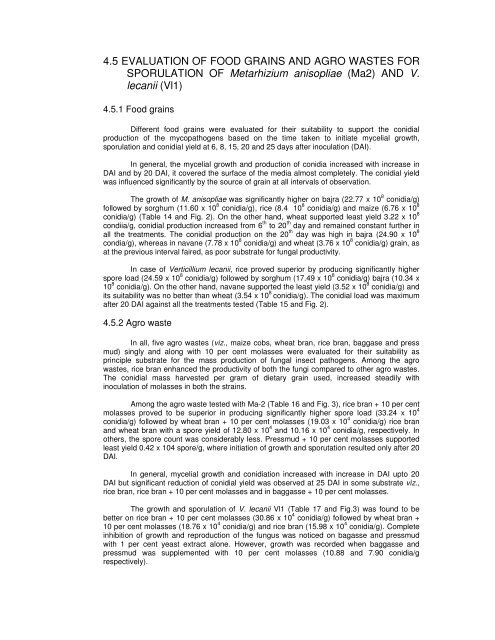ISOLATION AND CHARACTERIZATION OF ENTOMOPATHOGENIC ...
ISOLATION AND CHARACTERIZATION OF ENTOMOPATHOGENIC ...
ISOLATION AND CHARACTERIZATION OF ENTOMOPATHOGENIC ...
Create successful ePaper yourself
Turn your PDF publications into a flip-book with our unique Google optimized e-Paper software.
4.5 EVALUATION <strong>OF</strong> FOOD GRAINS <strong>AND</strong> AGRO WASTES FOR<br />
SPORULATION <strong>OF</strong> Metarhizium anisopliae (Ma2) <strong>AND</strong> V.<br />
lecanii (Vl1)<br />
4.5.1 Food grains<br />
Different food grains were evaluated for their suitability to support the conidial<br />
production of the mycopathogens based on the time taken to initiate mycelial growth,<br />
sporulation and conidial yield at 6, 8, 15, 20 and 25 days after inoculation (DAI).<br />
In general, the mycelial growth and production of conidia increased with increase in<br />
DAI and by 20 DAI, it covered the surface of the media almost completely. The conidial yield<br />
was influenced significantly by the source of grain at all intervals of observation.<br />
The growth of M. anisopliae was significantly higher on bajra (22.77 x 10 8 conidia/g)<br />
followed by sorghum (11.60 x 10 8 conidia/g), rice (8.4 10 8 conidia/g) and maize (6.76 x 10 8<br />
conidia/g) (Table 14 and Fig. 2). On the other hand, wheat supported least yield 3.22 x 10 8<br />
condiia/g, conidial production increased from 6 th to 20 th day and remained constant further in<br />
all the treatments. The conidial production on the 20 th day was high in bajra (24.90 x 10 8<br />
condia/g), whereas in navane (7.78 x 10 8 conidia/g) and wheat (3.76 x 10 8 conidia/g) grain, as<br />
at the previous interval faired, as poor substrate for fungal productivity.<br />
In case of Verticillium lecanii, rice proved superior by producing significantly higher<br />
spore load (24.59 x 10 8 conidia/g) followed by sorghum (17.49 x 10 8 conidia/g) bajra (10.34 x<br />
10 8 conidia/g). On the other hand, navane supported the least yield (3.52 x 10 8 conidia/g) and<br />
its suitability was no better than wheat (3.54 x 10 8 conidia/g). The conidial load was maximum<br />
after 20 DAI against all the treatments tested (Table 15 and Fig. 2).<br />
4.5.2 Agro waste<br />
In all, five agro wastes (viz., maize cobs, wheat bran, rice bran, baggase and press<br />
mud) singly and along with 10 per cent molasses were evaluated for their suitability as<br />
principle substrate for the mass production of fungal insect pathogens. Among the agro<br />
wastes, rice bran enhanced the productivity of both the fungi compared to other agro wastes.<br />
The conidial mass harvested per gram of dietary grain used, increased steadily with<br />
inoculation of molasses in both the strains.<br />
Among the agro waste tested with Ma-2 (Table 16 and Fig. 3), rice bran + 10 per cent<br />
molasses proved to be superior in producing significantly higher spore load (33.24 x 10 4<br />
conidia/g) followed by wheat bran + 10 per cent molasses (19.03 x 10 4 conidia/g) rice bran<br />
and wheat bran with a spore yield of 12.80 x 10 4 and 10.16 x 10 4 conidia/g, respectively. In<br />
others, the spore count was considerably less. Pressmud + 10 per cent molasses supported<br />
least yield 0.42 x 104 spore/g, where initiation of growth and sporutation resulted only after 20<br />
DAI.<br />
In general, mycelial growth and conidiation increased with increase in DAI upto 20<br />
DAI but significant reduction of conidial yield was observed at 25 DAI in some substrate viz.,<br />
rice bran, rice bran + 10 per cent molasses and in baggasse + 10 per cent molasses.<br />
The growth and sporulation of V. lecanii Vl1 (Table 17 and Fig.3) was found to be<br />
better on rice bran + 10 per cent molasses (30.86 x 10 4 conidia/g) followed by wheat bran +<br />
10 per cent molasses (18.76 x 10 4 conidia/g) and rice bran (15.98 x 10 4 conidia/g). Complete<br />
inhibition of growth and reproduction of the fungus was noticed on bagasse and pressmud<br />
with 1 per cent yeast extract alone. However, growth was recorded when baggasse and<br />
pressmud was supplemented with 10 per cent molasses (10.88 and 7.90 conidia/g<br />
respectively).
















